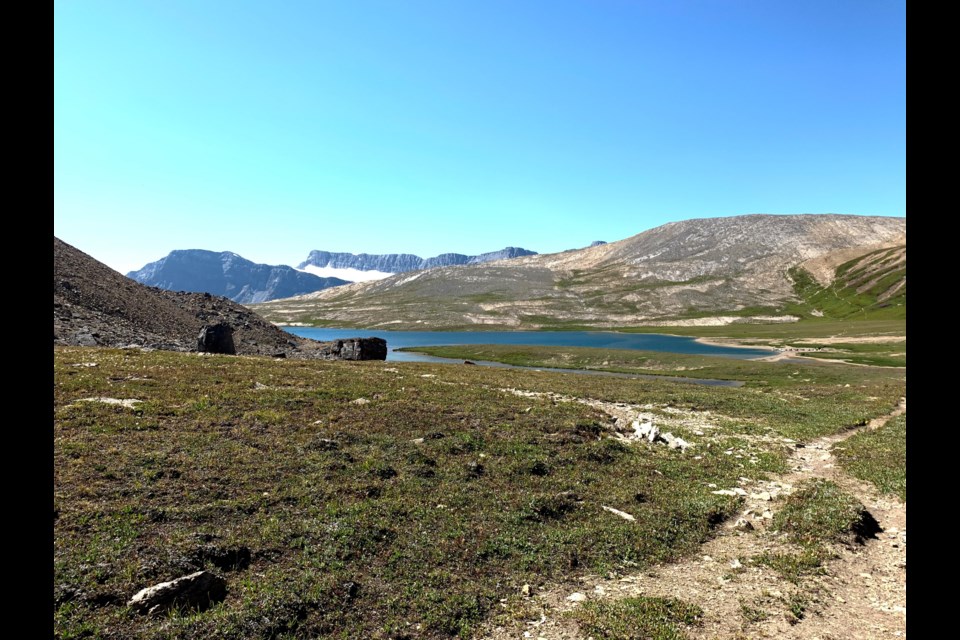LAKE LOUISE – Thousands of non-native trout have been poisoned and killed in a remote lake in Banff National Park to protect a threatened native fish species and its habitat.
Parks Canada pumped rotenone into Katherine Lake last week, which killed an estimated 5,000 Yellowstone cutthroat trout, an American subspecies that does not belong in Canada.
Aquatics experts say it’s all part of a bigger plan to save westslope cutthroat trout, a federally listed threatened species in Alberta that has disappeared from all but 10 per cent of its historic habitat in this province.
They say removal of the non-native fish in Katherine Lake this year, combined with the poisoning of invasive brook trout in nearby Helen Lake last year, now makes it feasible to put the at-risk westslope cutthroat into Helen Creek in the future.
“I know it’s sad for people because it’s a nice lake to fish, but from an ecological perspective, the decision for the westslope cutthroat trout was pretty clear,” said Shelley Humphries, a Parks Canada aquatics specialist for Lake Louise, Yoho and Kootenay.
“We were getting Yellowstone escaping over the barrier waterfall and we were detecting their DNA and presence of some adult fish down in the creek area, so it was very clear that we had to remove the threat from that location from a species-at-risk perspective.”
Rotenone, a naturally occurring compound derived from the roots of a tropical plant in the bean family, enters the bloodstream of fish and kills them essentially through suffocation.
American agencies have had great success with rotenone for fish restoration projects. Parks Canada did a successful pilot project with the poison at Hidden Lake in 2018-19, killing about 5,000 non-native fish there.
Both Helen Lake and Katherine Lake, which are located off the Icefields Parkway near Bow Lake, did not have any fish in them until the 1940s and 1950s when they were introduced for sport fishing.
The outlet stream that comes together from the two alpine lakes, known as Helen Creek, eventually feeds into the Bow River between Hector and lakes.
Humphries said a second treatment of Helen Lake was needed this year following last year’s project to make sure all brook trout are dead.
“The locations that have brook trout should be treated twice, based on experience and advice from Montana, because if the eggs are in the gravel already, the eggs are not susceptible to the rotenone,” she said.
“We think we got them all last year but we needed to be sure, especially because brook trout are just so capable of completely re-populating an area, even with very small numbers.”
As for Katherine Lake, the Yellowstone cutthroat had to go, too.
“It doesn’t belong in Canada; it’s from the U.S and it’s a sister species to westslope cutthroat,” Humphries said.
“It makes hybrids in the same way that the rainbow do with the westslope cutthroat.”
After the poison was applied in the upper watershed near the lakes and streams, Parks Canada applied a deactivation compound – potassium permanganate – to remove the rotenone from the environment.
It turns the water pink, and because Helen Creek flows beneath the Icefields Parkway, a no-stopping zone was implemented to prevent drivers from stopping and causing traffic jams like they did during last year’s Helen Lake project.
“Last year we saw lots of unsafe driving behaviour from the public, similar to bear jams, people coming to a complete and sudden stop obstructing traffic in both directions,” Humphries said, noting they were curious of the pink water. “We felt that was unsafe.”
The next step in the plan is to introduce pure westslope cutthroat into Helen Creek in the next couple of years.
Aquatics specialists will monitor for the benthic invertebrates – like worms, for example – to make sure they have recovered from the poisoned lakes.
“They also get affected by the treatment and they will be the food supply for the future fish that are going to be in the creek,” Humphries said.
“Based on our results at Hidden Lake, the stream will have a complete rebound on the benthic invertebrate community within a year.”
Next year, Parks Canada plans to remove brook trout from Margaret Lake above Hector Lake. Diaries from early explorers of the region indicate there was a healthy population of westslope cutthroat trout in Margaret Lake.
“It’s a really logical place for us to go next,” said Humphries.
Once inhabiting most streams in southwestern Alberta from the alpine to the prairies, westslope cutthroat trout were listed as threatened under Alberta’s Wildlife Act in 2009 and threatened under the federal Species At Risk Act (SARA) in 2013.
This designation was due to the subspecies’ small distribution and continuing decline in numbers, as well as the severely fragmented nature of populations, ongoing destruction of habitat, and barriers to dispersal making immigration between populations difficult.
Humphries said Parks Canada is wanting to make a difference to the future of the species with its projects.
“This is the scope and scale that we need to be working at to make meaningful gains for recovering westslope cutthroat trout,” Humphries said.
“I think that we’re trying to show leadership in this regard and we’re really pleased with how everything is working out.”
Read more from RMOToday.com




